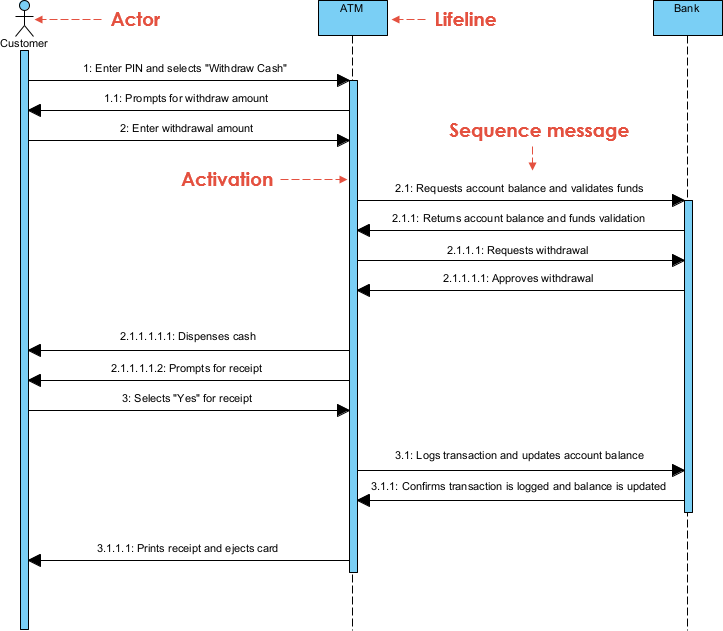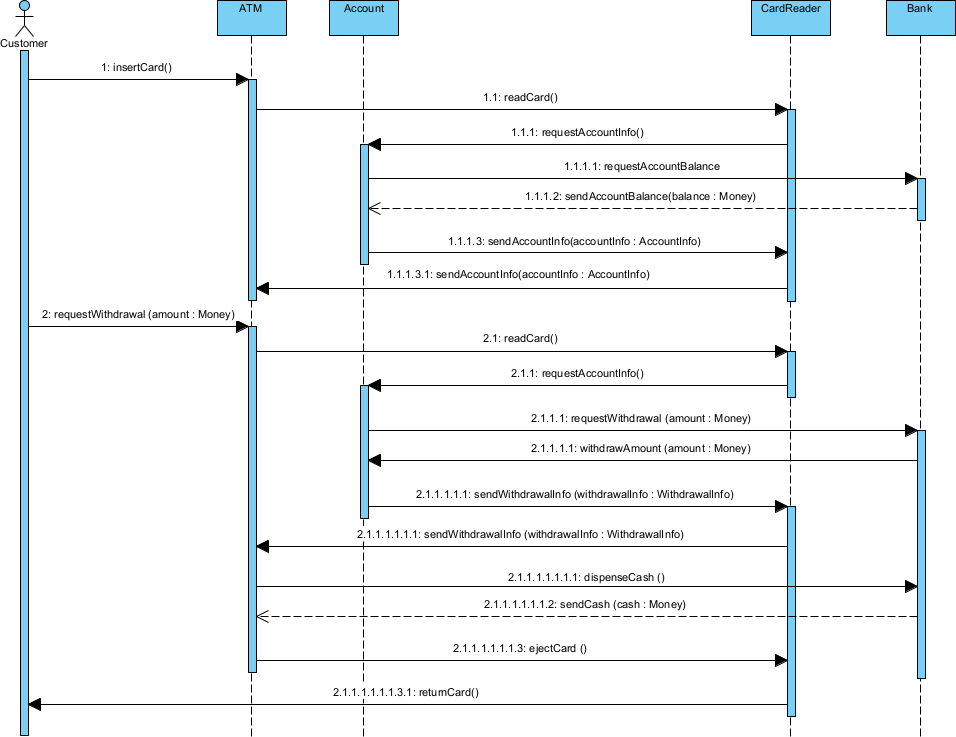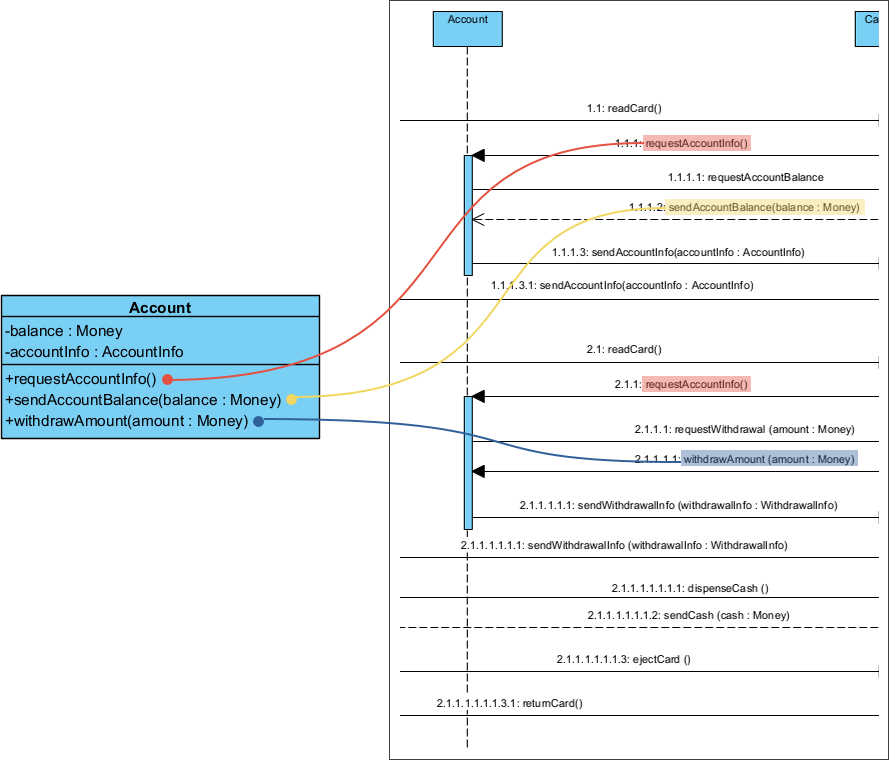Refining Sequence Diagrams: From Design to Implementation and MVC
Benefits of Iterative and Incremental Development in OOAD
Iterative and incremental are two concepts that are widely used in Object-Oriented Analysis and Design (OOAD). These concepts are used to describe the development process of a software system.
Iterative development is a process in which the software is developed in small increments. Each increment adds some functionality to the software, and the software is tested after each increment. The feedback from the testing is used to refine the requirements and design of the system. The process is repeated until the software meets the desired level of functionality and quality.
Incremental development is a process in which the software is developed in a series of increments, each increment adding some functionality to the software. The increments are designed to be independent of each other, and each increment is tested before the next increment is developed. The process is repeated until the software meets the desired level of functionality and quality.
The benefits of iterative and incremental development in OOAD are numerous. Some of the key benefits are:
- Better feedback: The iterative and incremental approach provides better feedback throughout the development process. The feedback from testing is used to refine the requirements and design of the system, which leads to a better quality product.
- Reduced risk: The iterative and incremental approach reduces the risk of developing a system that does not meet the requirements. By testing the software after each increment, the team can catch and correct any issues early on in the development process.
- Flexibility: The iterative and incremental approach provides flexibility in the development process. The team can adjust the requirements and design of the system as needed throughout the development process.
- Faster time to market: The iterative and incremental approach allows for faster time to market. The team can release functional increments of the software as they are developed, which allows the software to be used by customers earlier.
- Improved collaboration: The iterative and incremental approach encourages collaboration between team members. The team can work together to develop and test each increment, which leads to a better quality product.
The concepts of iterative and incremental development are important concepts in OOAD. These concepts provide numerous benefits, including better feedback, reduced risk, flexibility, faster time to market, and improved collaboration. By using these concepts, software development teams can create high-quality software that meets the needs of their customers.
How to Pairing Use Case Scenarios and Sequence Diagrams for Software Development
In software engineering, sequence diagrams are used to represent the interactions between objects in a system. They are used to model a system’s behavior by showing how objects communicate with each other to achieve specific goals. Sequence diagrams are widely used in the design phase of software development, as they help to identify the classes, methods, and attributes required to implement a system. However, the sequence diagram used in the design phase is often refined to a more specific system sequence diagram that is tailored to the actual implementation of the system. In this article, we will discuss the refinement of a sequence diagram for the design phase to an implementation form system sequence diagram that helps to identify classes, its methods, and attributes.
To begin with, let’s first discuss the design phase sequence diagram. In the design phase, the sequence diagram is typically used to model the interactions between the system’s components and the user. It is used to identify the various components of the system and how they interact with each other to achieve specific goals. This is done by going through different use case scenarios, which are essentially a series of steps that represent how the user interacts with the system.
Once the design phase sequence diagram has been created, it is refined into a more specific system sequence diagram that is tailored to the actual implementation of the system. This is done by inspecting the incoming messages to the objects, which help to identify the detailed messages required for each object. These detailed messages are good for identifying the methods and parameters required for a class.
The system sequence diagram is often refined further into an MVC (Model-View-Controller) sequence diagram. The MVC pattern is a software architecture pattern that separates the system into three distinct components: the model, the view, and the controller. The model represents the data and the business logic, the view represents the presentation layer, and the controller represents the logic that mediates between the model and the view.
The MVC sequence diagram helps to identify the classes, methods, and attributes required for each component of the system. It shows how the user interacts with the view, which in turn communicates with the controller, which then interacts with the model. This sequence of interactions helps to identify the various classes and methods required for each component.
Using Sequence Diagrams to Identify Classes, Methods, and Attributes in Software Development
In software development, when multiple sequence diagrams for a use case have objects with the same name, it can be an indication that these objects should be consolidated into a single class. This is because these objects likely have similar functionality and can be better organized and managed as a single class.
To determine the methods and attributes required for this consolidated class, the incoming messages from different sequence diagrams can be analyzed. These incoming messages represent the interactions between objects in different scenarios and can provide insights into the functionality that is needed for the consolidated class. By examining the messages and identifying the operations and parameters needed to carry out the use case, the required methods and attributes for the consolidated class can be identified.
Once the methods and attributes are identified, they can be added to the consolidated class, and the class can be implemented in the system. This approach can help to improve the organization and efficiency of the system’s code by reducing duplication and improving maintainability.
Example – Withdraw Cash (Normal Scenario – Successful Withdrawal with Receipt)

Let’s Refine the Sequence Diagram with More Details including methods and parameters in the message

The Account Class with Methods and Attributes identified from the Normal Scenario

How to Consolidate Objects into Classes Based on Sequence Diagram
here is a step-by-step guide to elaborate a use case to a set of sequence diagrams and identify participating classes and their methods and attributes:
- Identify the use case: Identify the specific use case you want to model, such as “Place an Order.”
- Identify the actors: Identify the actors involved in the use case, such as the Customer and the System.
- Create the use case scenario: Create a step-by-step scenario for the use case. For example, for the “Place an Order” use case, the scenario might include steps like “The Customer selects items from the menu” and “The System calculates the total cost of the order.”
- Create a sequence diagram for the use case: Use the scenario to create a sequence diagram for the use case. Identify the objects involved in the use case and the messages exchanged between them.
- Analyze the sequence diagram: Look for objects with the same name from different sequence diagrams with the corresponding use case scenarios of a use case. This is an indication that these objects may be consolidated into a single class.
- Analyze the incoming messages: Analyze the incoming messages to identify the operations and parameters needed to carry out the use case. This will help you identify the methods and attributes needed for the consolidated class.
- Identify the methods and attributes for the consolidated class: Based on the analysis of the incoming messages, identify the methods and attributes needed for the consolidated class. For example, if the incoming messages require the “Order” class to calculate the total cost of the order, then the class should have a method for calculating the total cost and an attribute for storing the items in the order.
To identify all the necessary requirements for a class, including its services (methods and attributes), you should apply the above steps to all sequence diagrams (all use case scenarios) for each use case in your system. This will allow you to identify the participating classes and their methods and attributes, which in turn will enable you to consolidate objects into classes and reduce duplication in your code.
Summary
To consolidate objects into classes based on sequence diagram analysis, you need to analyze the sequence diagrams for a given use case and identify any objects that have the same name across different use case scenarios. By doing this, you can determine which objects should be combined into a single class, which can help improve the organization and efficiency of the system’s code. By identifying incoming messages to the objects and analyzing the operations and parameters required for each, the necessary methods and attributes for the consolidated class can be determined. Finally, the consolidated class can be implemented in the system. This process can be repeated for each use case in the system to identify participating classes and their methods and attributes. By following this approach, the efficiency of the system’s code can be improved, reducing duplication and improving maintainability.

